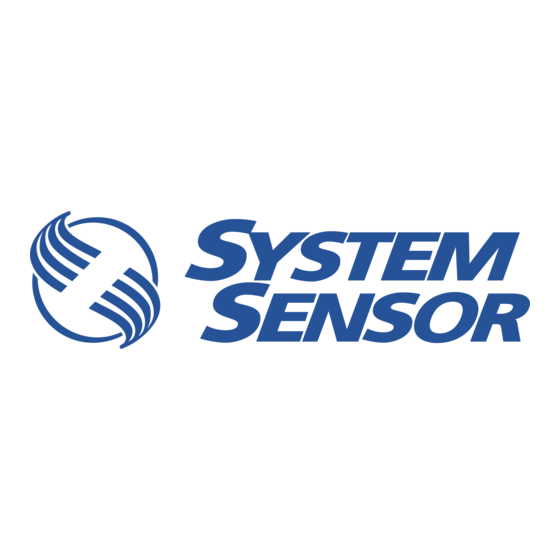
Advertisement
Quick Links
INSTALLATION AND MAINTENANCE INSTRUCTIONS
B116LP Plug-in Detector Base
For use with the following smoke detectors:
In US:
1151, 2151
In Canada:
1151A, 2151A
In Europe:
1151E, 2151E
Specifications
Base Diameter:
Base Height:
Weight:
Mounting:
Operating Temperature Range:
Operating Humidity Range:
Electrical Ratings – includes base and detector
System Voltage:
Maximum Ripple Voltage:
Start-up Capacitance:
Standby Ratings:
Alarm Ratings:
Relay Contact Ratings:
Resistive or Inductive (60% power factor) Load
Form C:*
Reset Voltage:
Reset Time:
Start-up Time:
*For Canadian installations relay contact ratings are 2.0A @ 30 VAC/DC.
Before Installing
Please thoroughly read the System Sensor manual I56-407,
Guide for Proper Use of System Smoke Detectors, which pro-
vides detailed information on detector spacing, placement,
zoning, wiring, and special applications. Copies of this
manual are available at no charge from System Sensor. (For
installation in Canada, please refer to CAN4-S524, Standard
for the Installation of Fire Alarm Systems and CEC Part 1,
Sec. 32.)
NOTICE: This manual should be left with the owner/user
of this equipment.
IMPORTANT: The detector used with this base must be
D150-01-00
6.2 inches (157 mm)
0.95 inches (24 mm)
0.3 lb. (130 g)
4-inch square box with or without plaster ring. Min. Depth–1.5 inches
4-inch octagon box. Min. Depth–1.5 inches
3-1/2 inch-octagon box. Min. Depth–1.5 inches
50 mm box
60 mm box
70 mm box
0° to +49°C (32° to 120°F) US and Canadian Installations
10° to 60°C (14° to 140°F) European Installations
10% to 93% Relative Humidity
24 VDC
4 Volts peak to peak
0.02µF Maximum
15 VDC Minimum
35 VDC Maximum
120 µA Maximum
8 V Minimum at 16 mA
12 V Maximum at 100 mA
(Alarm current MUST be limited to 100 mA maximum by the control panel.)
2.0A @ 30 VAC/DC
0.6A @ 110 VDC
1.0A @ 125 VAC
1.4 VDC Minimum
0.3 Seconds Maximum
34.0 Seconds Maximum
1
tested and maintained regularly following NFPA 72 require-
ments. The detector used with this base should be cleaned
at least once a year.
General Description
The model B116LP plug-in detector base is used with
System Sensor model 1151, 1151A, and 1151E ionization
detector heads and model 2151, 2151A, and 2151E photo-
electronic detector heads. The capability of plugging these
detectors into a variety of special bases makes them more
versatile than equivalent direct-wired models. Refer to the
System Sensor catalog for other available plug-in detector
bases.
3825 Ohio Avenue,
St. Charles, Illinois 60174
1-800-SENSOR2, FAX: 630-377-6495
I56-599-03R
Advertisement

Summary of Contents for System Sensor B116LP
- Page 1 Copies of this General Description manual are available at no charge from System Sensor. (For The model B116LP plug-in detector base is used with installation in Canada, please refer to CAN4-S524, Standard...
- Page 2 The B116LP base is intended for use in 2-wire systems, Figure 1. Mounting base to box: with screw terminals provided for power and relay contact connections. These bases MUST be current limited by the system control panel in the alarm state.
- Page 3 Figure 2. Typical wiring diagram: (+) POWER LOOP COM CONTACT N.C. AUXILIARY N.O. FORM C (–) POWER LOOP CLASS A OPTIONAL WIRING A78-1577-00 Once all the detector bases have been wired and mounted, remove the detector from the base once the tamper-resist- and the loop wiring has been checked, the detector heads ance feature has been activated, place a small-bladed may be installed in the bases.
- Page 4 Please refer to insert for the Limitations of Fire Alarm Systems Three-Year Limited Warranty System Sensor warrants its enclosed smoke detector base to be free from Charles, IL 60174. Please include a note describing the malfunction and defects in materials and workmanship under normal use and service for a suspected cause of failure.













Need help?
Do you have a question about the B116LP and is the answer not in the manual?
Questions and answers